

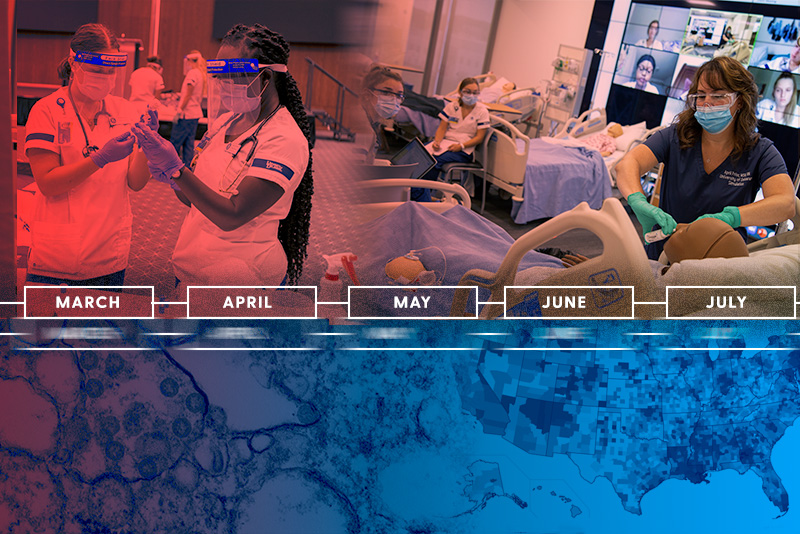
The future of healthcare
Photos by Ashley Barnas | Illustration by Jeffrey C. Chase March 11, 2021
UD College of Health Sciences experts discuss the long-term impact of the pandemic
Over the past year, the coronavirus (COVID-19) pandemic has changed the way healthcare is delivered, experienced and evaluated, whether it’s the growing popularity of virtual patient visits or the speedy advancement of diagnostic tests and vaccines. At the same time, it has also exposed critical challenges in the healthcare infrastructure, including the growing need for a skilled workforce.
Those changes — and challenges — are likely to remain long after the pandemic has ended, according to some of the University of Delaware’s top experts from the College of Health Sciences. They reflect on how the past year will reshape patient care in the future.
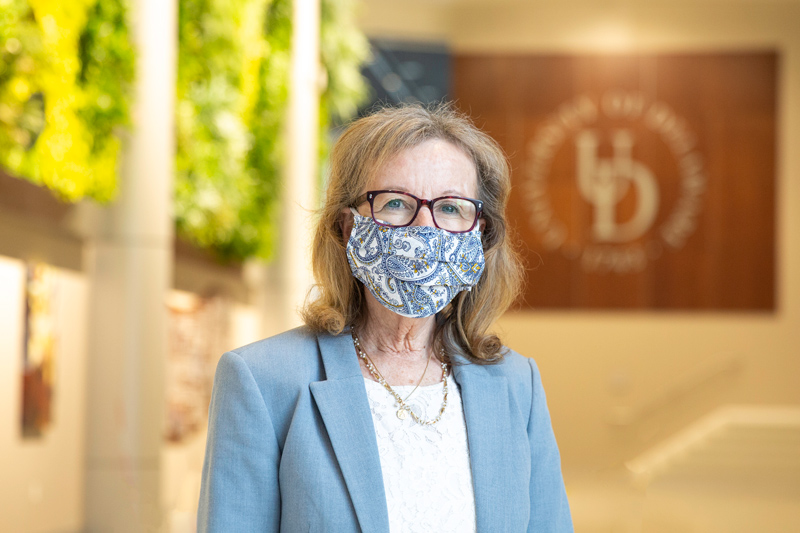
Kathleen S. Matt, dean of the College of Health Sciences
Q: What skills will future healthcare professionals need to be successful and how is the University of Delaware preparing students to be the next generation workforce?
Matt: Healthcare will be more flexible, including multiple ways to access and receive care. Future healthcare professionals must be critical thinkers, nimble, resilient, decisive and fast in action. They also need an appreciation for the science of health and how that impacts diagnosis, treatment and care.
Our students have been learning in the midst of COVID, and we are leveraging the opportunity to train our students with safety constraints in place. Our students have discovered ways to connect with patients — whether that’s in telemedicine/telehealth or while wearing a mask and showing compassion and care with restraints in place. We have not held back in terms of clinical experiences and in-person simulations.
All of this requires infrared thermometers in the building, daily health surveys and extensive personal protection equipment (PPE). They are learning and having an experience that previously they would have only read about.
Rita Landgraf, director of Partnership for Healthy Communities
Q: With COVID exposing how people of color are disproportionately affected by life-threatening health conditions, how can we reduce disparities and better address social determinants of health?
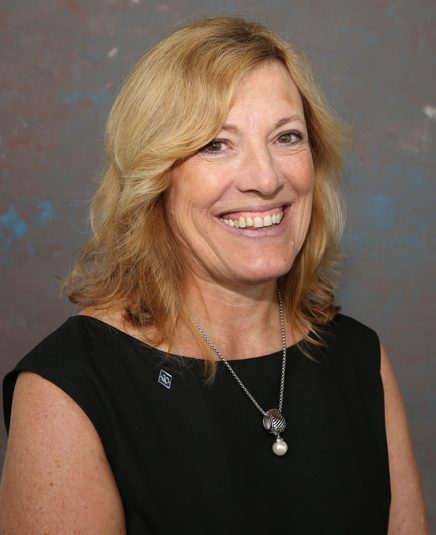
Landgraf: Health inequities lead to health disparities. If you ignore the health inequities you'll never eradicate the disparities. They go hand in hand. Really validating that through our science is important, but it is equally important from an engagement perspective to be able to link students to communities with high levels of inequities to gain a greater appreciation for the root causes. COVID put a spotlight on what has been going on in these communities that have been made vulnerable. Our status quo would continually leave behind communities of color.
I think where the college has played a significant role and opportunity is through our engagement with the community. There’s no greater training. We don't have to simulate it. Being able to link the exposure and how it plays out differently depending on where you live and your zip code has been important for students to see — as is how we work with communities to bring about strategies for change.
Partnerships are critically important. What will stay is these relationships, and I think we will be able to build upon that because of the pandemic. More work needs to be done, and we have to keep showing up. My hope is that we bring the community into UD, too. If we keep showing up, that can be reciprocated by enhancing diversity of our student body and our faculty and staff.
Jennifer Horney, founding director Epidemiology program
Q: Many have said the pandemic exposed the country’s lack of disaster readiness, particularly with regard to its workforce. How can public health recover from the pandemic?

Horney: The public health workforce plays an essential role in the response to disasters and emergencies. Public health nurses staff evacuation shelters, providing medical treatment and preventing outbreaks of disease. Environmental health staff monitor the safety of public and private water systems, inspect facilities like restaurants and hotels before they reopen, and conduct environmental health assessments. Epidemiologists establish public health surveillance systems to monitor health, identify outbreaks, and collect and analyze disaster data.
The U.S. began its response to the COVID-19 pandemic with a deficit of 250,000 public health workers and budgets for public health emergency preparedness that had been steadily declining each year since the financial crisis of 2008. Since 2008, 62% of the nation’s more than 3,000 local health departments had flat or reduced funding and average overall declines in spending averaged 10.3%.
With two-thirds of current public health workers reporting burnout, rebuilding the public health system following COVID-19 will require both urgent interventions and long-term policy changes to ensure the system can robustly respond to public health emergencies in the future.
Liz Speakman, senior associate dean, School of Nursing
Q: How has the training of nurses changed in light of the pandemic
Speakman: I am not sure it has. Nursing education is rooted in a curriculum where what you learn in didactic and what you practice in the clinical environment occurs simultaneously in the same course and in the same semester. That will not change.
Nursing is a very hands-on profession, so connecting with a student virtually is not always consistent with the human touch we pride ourselves on. One thing that is for sure, our nursing students have demonstrated resilience and fortitude similar to their nursing counterparts. I have no doubt they can weather any unforeseen events in the future and will make valuable contributions to the nursing profession and healthcare delivery.
The pandemic has heightened the need for team-based approaches to care, another valuable attribute that has consistently been the tenet of the nurse practitioner (NP) practice. It is for that reason that a new elective, Nursing in Primary Care, was developed in the School of Nursing for undergraduate students and will be offered for the first time in summer 2021. We believe this will help our students understand the vital role the NP has in primary healthcare.
Esther Biswas, chair of the Department of Medical and Molecular Sciences
Q: The pandemic exposed the important work being done behind the scenes by medical lab professionals who have handled countless tests while juggling other lab responsibilities. With so many of these people scheduled to retire in the coming years, how can we recruit more people to the profession?
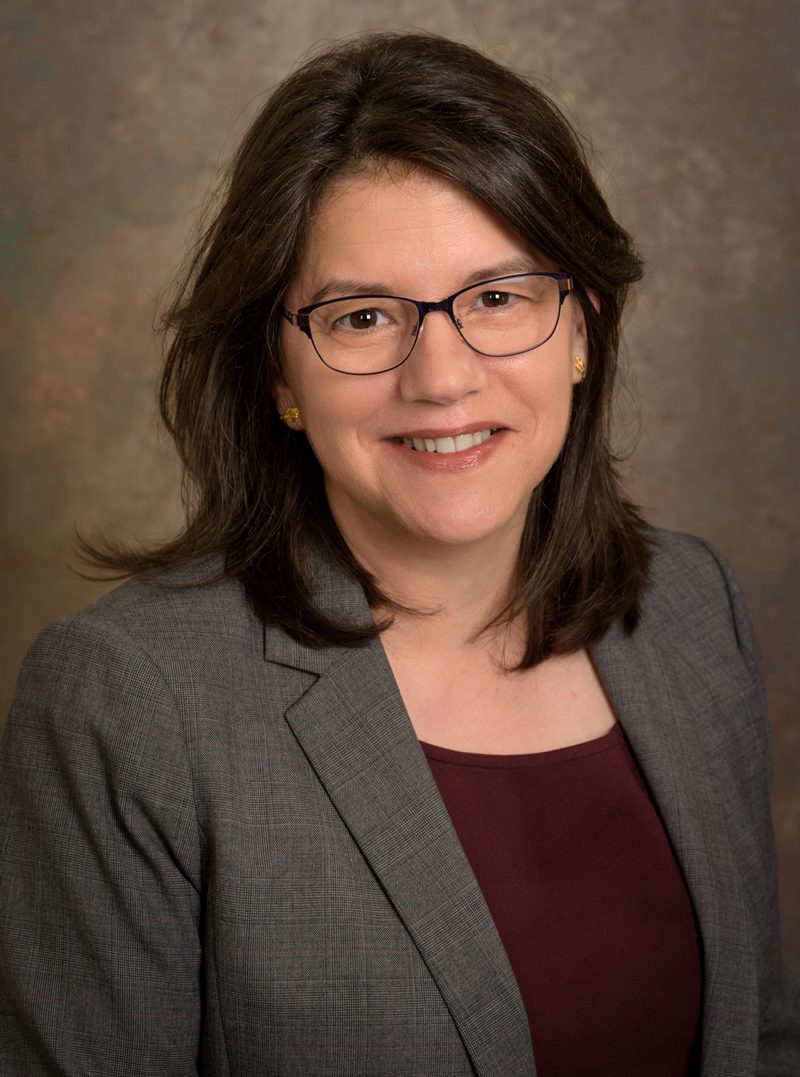
Biswas: The COVID-19 pandemic has been a grim reminder from the standpoint of the profession of laboratory medicine of the critical shortage of credentialed laboratory professionals. The supply of medical technologists, clinical laboratory scientists, molecular Ph.Ds, clinical pathologists, medical laboratory technicians and other laboratory scientists available to work in the nation’s labs is finite. Training programs take years to produce credentialed workers to perform laboratory testing. The workforce shortage is exacerbated by aging out and retirement of laboratory professionals, and decreasing numbers of academic institutions that offer MLS/MLT programs.
What can we do to recruit more individuals to the profession? Two avenues are essential to increase the numbers in the clinical laboratory workforce — increased public awareness campaigns on the critical role of laboratory testing in medicine, who performs our laboratory tests and the path to the profession.
Federal support of MLS/MLT programs also is necessary, not only for enticing students to join through scholarships, but also to provide the necessary infrastructure to aid in the delivery of these high tech educational programs. Often, society doesn't act until a crisis is at hand, with the laboratory science workforce dwindling, we may not have had the human resources to handle the testing associated with the pandemic if it had happened 5-10 years down the road.
Carolyn Haines, director of the Nurse Managed Primary Care Center
Q: The patient experience has changed dramatically during the pandemic. Moving forward, how do you see patient engagement changing to accommodate these new ways of “seeing” patients?
Haines: Healthcare and engagement with patients will need to reflect the changes that have occurred. Telehealth use and reimbursement has had a dramatic evolution in the past year, with hope that this continues post-COVID. The benefits are many — expanding our care reach with accessibility to more patients that previously may have transportation or mobility issues; convenience; prevention of infectious disease spread and decreased missed appointments. Telehealth visits are typically shorter than in-person visits, which can increase the number of patients seen in a day, increasing access to more patients.
Telehealth also gives the provider a unique look at the patient’s surroundings and sometimes allows providers to connect with family members/support members of the patient. Patient engagement will need to adapt to these changes to encourage patients to continue routine care and problem visits, with emphasis on the availability of the improved technology.
Beth Finkle, director of Employee Health and Wellbeing
Q: Many of us have spent the last year working from home and juggling multiple responsibilities. How do we move forward after the pandemic applying the benefits and disadvantages of these work experiences during this time?
Finkle: Now more than ever, we have to connect people to resources that help them to feel their best, as well as services to create more energy and leverage healthcare, so that they can bounce back and recharge.
Well-being is not something we call on every now and then. It truly needs to be built into the way we work, the way we show up in our communities and the way we take care of ourselves each day. Self-care is no longer considered frivolous or selfish — it's imperative to accomplish the load the current world is handing us.
People are more open to wellbeing because they know their holistic wellbeing has never been more needed. As healthcare providers, being able to create tools and resources that are adaptable and accessible will really move the needle towards optimal health because we now have a level of personal buy-in that we have never seen before. Wellbeing and having health equity for all finally has the spotlight it has always deserved.
Christine Cook, director of clinical research and services, Department of Communications Sciences and Disorders
Q: The pandemic transformed your clinic from one that was mostly in-person to one that is now mostly telehealth. Do you expect that trend to remain?
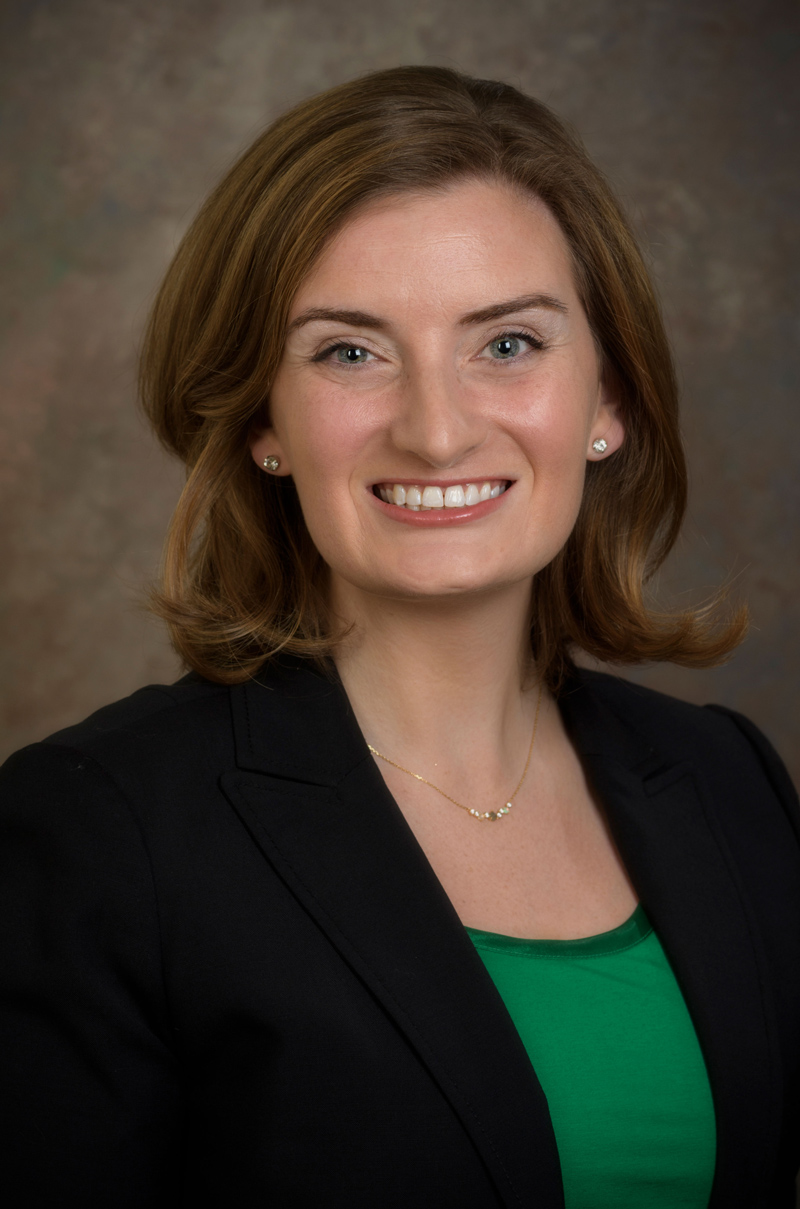
Cook: I don't think we're ever going to go back to 100% in-person services. I really could see it being 50/50 telehealth and in-person care, and, to be fair, some of our patients with the best outcomes have engaged in a hybrid model of in-person and telehealth treatment. Telehealth is here to stay. I'm on the Delaware Telehealth Steering Committee, and for years we were a group of advocates fighting to get telehealth to be more widely accepted. Then COVID happened, and everybody hopped on the bandwagon in a very unexpected way.
It’s made such a difference in our ability to reach people who weren't considered homebound to qualify for in-home care but it took a lot of work for them to get to and from the clinic. Outpatient services can be challenging because by the time our clients get to the clinic, many are exhausted by the work it takes to prepare, travel and get to the session. Now, our clients don't have to drive places, and there's not a barrier of transportation. We have the ability to truly meet people where they're at and develop personalized and functional treatment plans using their home environment and family care partners.
I am incredibly proud of the Speech-Language-Hearing Clinic team because we pivoted so quickly and have continued to evolve in so many ways. When COVID hit, we took two weeks to develop our telepractice protocols and train our staff and students. A couple of months later, when we were just getting comfortable with telepractice, we resumed in-person services with all of these added layers of protocol and check-ins and temperatures and PPE. Our department really pulled together in a big way to prioritize the care of our clients, the education of our students, and the safety of everyone involved over the last year.
Contact Us
Have a UDaily story idea?
Contact us at ocm@udel.edu
Members of the press
Contact us at 302-831-NEWS or visit the Media Relations website

